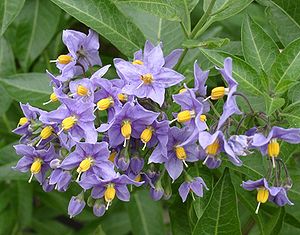Solanum crispum
| Solanum crispum | ||||||||||||
|---|---|---|---|---|---|---|---|---|---|---|---|---|

Solanum crispum |
||||||||||||
| Systematics | ||||||||||||
|
||||||||||||
| Scientific name | ||||||||||||
| Solanum crispum | ||||||||||||
| Ruiz & Pav. |
Solanum crispum is a plant type from the genus of Solanaceae ( Solanum ). Within the genus it is classified in the Dulcamaroid clade .
description
Vegetative characteristics
Solanum crispum grows as a shrub or small tree with a height of 0.4 to 5 m. The plants are occasionally loose and confused, especially in cultivated specimens. The young twigs are hairless or hairy with short, tree-like branching trichomes . The scars left by fallen leaves are a bit protruding. The bark of older branches is pale brownish-yellow, hairless and shiny. The sympodial units contain several leaves. The branching takes place monochasic or rarely dichasic .
The leaves are ovate to narrowly ovate, sometimes somewhat elliptical. They become 2.7 to 7.5 (rarely up to 10) cm long and 1 to 3 (rarely up to 7) cm wide, whereby they are longer and wider on young plants and plants that grow in the shade. Six to twelve pairs of lateral veins extend from the leaf axis. The upper side of the leaf is hairless or covered with a few tree-like branched trichomes along the main veins. The underside is also hairless or finely hairy with tree-like branching trichomes, this hairiness is somewhat thicker on the veins. The leaf margins are wavy or curled. The leaves are pointed to pointed towards the front, the base is cut off or slightly heart-shaped. The leaf stalks are 0.5 to 1 (rarely up to 2.2) cm long and not winged by a sloping leaf blade .
Inflorescences and flowers
The inflorescences are terminal, but are later surmounted by new shoots so that they appear to be standing sideways. They reach a length of 2 to 6 cm, are hairless or sparsely hairy with trichomes similar to those on the branches and leaves. Their outer shape is flat-ended or pyramidal, they branch five to seven times and consist of ten to 20 flowers . The flower stalks are surrounded by an approximately 0.5 mm long shaft, are hairless or have a few isolated trichomes. They grow to be 1 to 1.3 cm long, nodding at flowering time and widening from a base diameter of 0.5 mm to a diameter of 1.0 mm at the tip. The buds are initially spherical, later becoming elliptical. In the closed bud, the crown already stands far beyond the corolla tube.
The flowers have a calyx with a conical, 1 to 1.5 (rarely up to 2) mm long calyx tube, which is occupied with triangular to long-triangular calyx tips. The tips reach a length of 0.5 to 1 mm, are hairless or have a few isolated trichomes on the outside. The crown is purple in color, measures 1.2 to 2.5 cm in diameter and is lobed 3/4 to 7/8 of the length. The corolla lobes are flat or slightly bent back, densely hairy on the outside with simple or tree-shaped branched trichomes, at the tips the trichomes are a bit denser.
The stamens have anthers 3.5 to 5 mm long and 1.2 mm wide, which open through pores at the tips, which later widen into slits. The stamens are less than 0.5 mm fused to form a stamen tube, the free-standing part of the stamens is 1 to 1.5 mm long and hairless. The ovary is hairless or has a few unbranched and tree-shaped branched trichomes at the tip. The stylus is 0.6 to 1 cm long, with tree-shaped branched or unbranched trichomes along its entire length. The scar is club-shaped or head-shaped, its surface is finely papilla .
Fruits and seeds
The fruit is a spherical, bright red colored berry with a thin pericarp and a diameter of 0.8 to 1.0 cm. The flower stalks are lignified and bent back on the fruits. They measure 1.2 to 1.6 cm and have a diameter of 1 mm at the base. Each fruit contains about eleven seeds . These are reddish-brown, flattened, lenticular and 2 to 3 × 1.5 to 2 mm in size. The surface of the seeds is finely grained.
Distribution and locations
The species is distributed in Chile from Quillota to the south of the island of Chiloé and occurs at altitudes between 10 and 2500 m. Occasionally specimens have also been found in Argentina along the Chilean border. The species grows in Nothofagus forests, often in secondary vegetation or in moist microhabitats in an otherwise dry environment.
Systematics
The species is part of a species group around Solanum nitidum within the Dulcamaroid clade. In the entire distribution area, two different forms occur, which differ in the presence of hair on the stems and leaves. The hairy specimens were traditionally listed as Solanum congestiflorum . However, the different types of hair may also be due to differences in location.
proof
- Sandra Knapp: Solanum crispum . In: Solanaceae Source ( online ), July 2004, accessed March 20, 2011.